air condition SUZUKI SWIFT 2000 1.G Transmission Service Owner's Manual
[x] Cancel search | Manufacturer: SUZUKI, Model Year: 2000, Model line: SWIFT, Model: SUZUKI SWIFT 2000 1.GPages: 447, PDF Size: 10.54 MB
Page 251 of 447
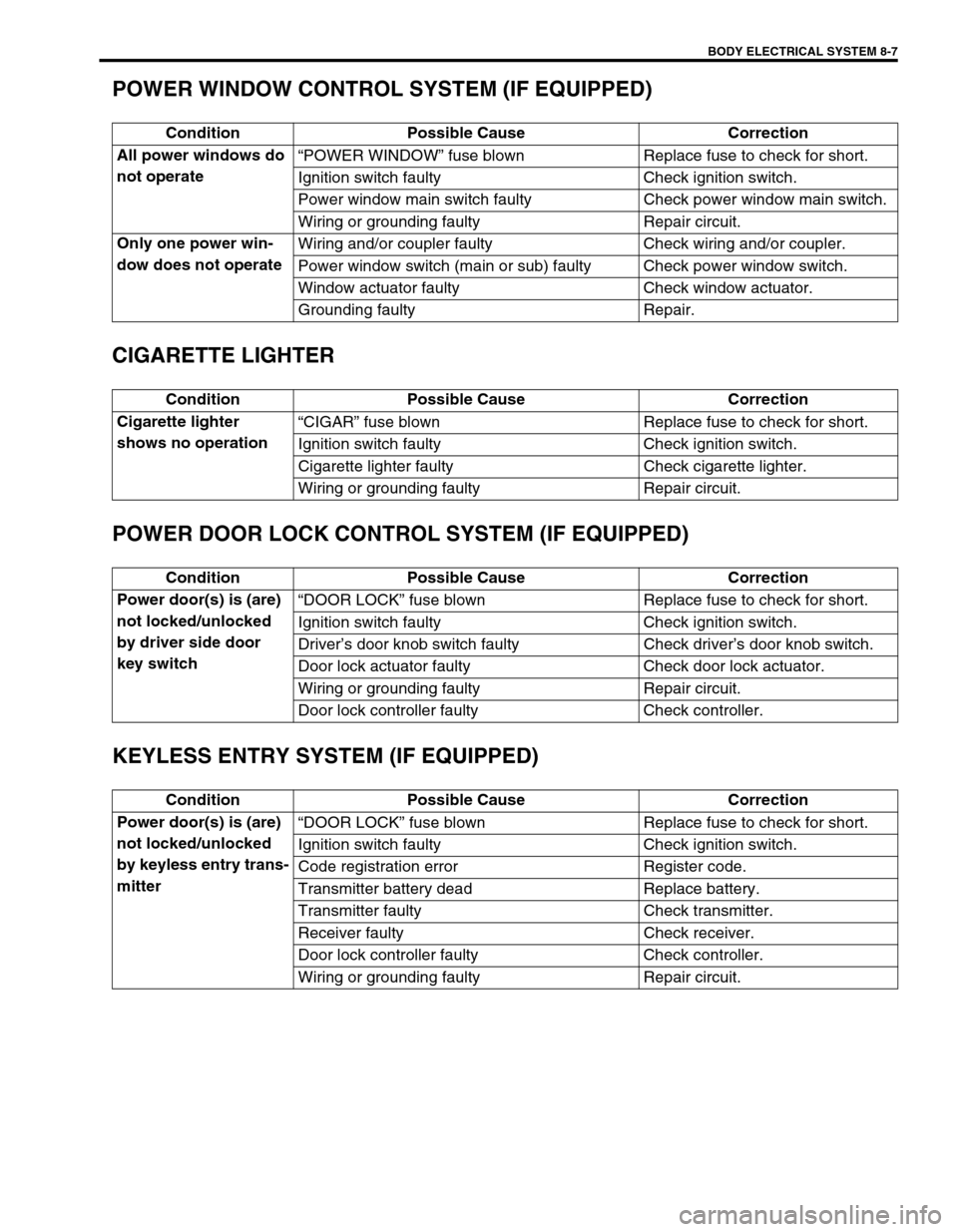
BODY ELECTRICAL SYSTEM 8-7
POWER WINDOW CONTROL SYSTEM (IF EQUIPPED)
CIGARETTE LIGHTER
POWER DOOR LOCK CONTROL SYSTEM (IF EQUIPPED)
KEYLESS ENTRY SYSTEM (IF EQUIPPED)
Condition Possible Cause Correction
All power windows do
not operate“POWER WINDOW” fuse blown Replace fuse to check for short.
Ignition switch faulty Check ignition switch.
Power window main switch faulty Check power window main switch.
Wiring or grounding faulty Repair circuit.
Only one power win-
dow does not operateWiring and/or coupler faulty Check wiring and/or coupler.
Power window switch (main or sub) faulty Check power window switch.
Window actuator faulty Check window actuator.
Grounding faulty Repair.
Condition Possible Cause Correction
Cigarette lighter
shows no operation“CIGAR” fuse blown Replace fuse to check for short.
Ignition switch faulty Check ignition switch.
Cigarette lighter faulty Check cigarette lighter.
Wiring or grounding faulty Repair circuit.
Condition Possible Cause Correction
Power door(s) is (are)
not locked/unlocked
by driver side door
key switch“DOOR LOCK” fuse blown Replace fuse to check for short.
Ignition switch faulty Check ignition switch.
Driver’s door knob switch faulty Check driver’s door knob switch.
Door lock actuator faulty Check door lock actuator.
Wiring or grounding faulty Repair circuit.
Door lock controller faulty Check controller.
Condition Possible Cause Correction
Power door(s) is (are)
not locked/unlocked
by keyless entry trans-
mitter“DOOR LOCK” fuse blown Replace fuse to check for short.
Ignition switch faulty Check ignition switch.
Code registration error Register code.
Transmitter battery dead Replace battery.
Transmitter faulty Check transmitter.
Receiver faulty Check receiver.
Door lock controller faulty Check controller.
Wiring or grounding faulty Repair circuit.
Page 252 of 447
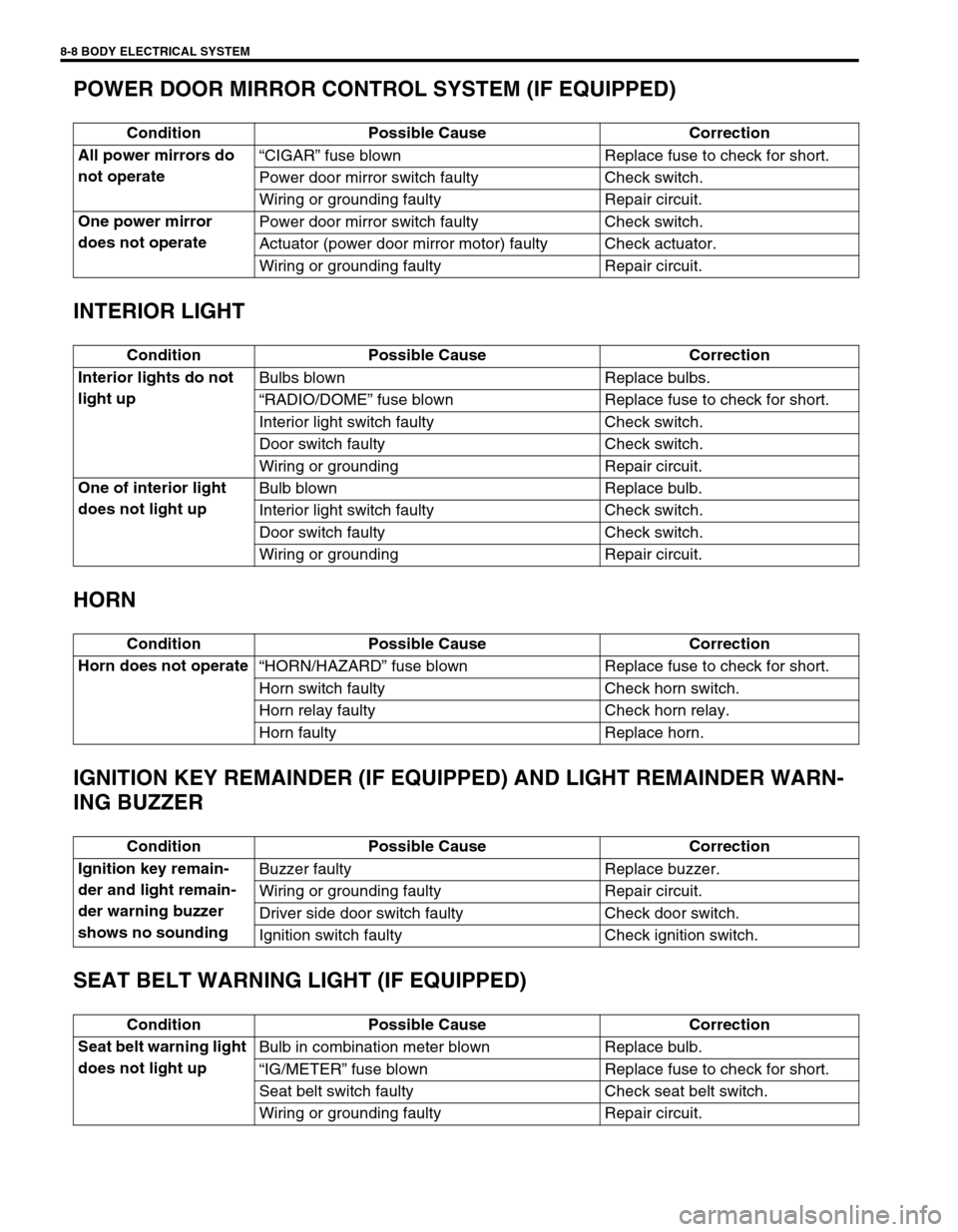
8-8 BODY ELECTRICAL SYSTEM
POWER DOOR MIRROR CONTROL SYSTEM (IF EQUIPPED)
INTERIOR LIGHT
HORN
IGNITION KEY REMAINDER (IF EQUIPPED) AND LIGHT REMAINDER WARN-
ING BUZZER
SEAT BELT WARNING LIGHT (IF EQUIPPED)
Condition Possible Cause Correction
All power mirrors do
not operate“CIGAR” fuse blown Replace fuse to check for short.
Power door mirror switch faulty Check switch.
Wiring or grounding faulty Repair circuit.
One power mirror
does not operatePower door mirror switch faulty Check switch.
Actuator (power door mirror motor) faulty Check actuator.
Wiring or grounding faulty Repair circuit.
Condition Possible Cause Correction
Interior lights do not
light upBulbs blown Replace bulbs.
“RADIO/DOME” fuse blown Replace fuse to check for short.
Interior light switch faulty Check switch.
Door switch faulty Check switch.
Wiring or grounding Repair circuit.
One of interior light
does not light upBulb blown Replace bulb.
Interior light switch faulty Check switch.
Door switch faulty Check switch.
Wiring or grounding Repair circuit.
Condition Possible Cause Correction
Horn does not operate
“HORN/HAZARD” fuse blown Replace fuse to check for short.
Horn switch faulty Check horn switch.
Horn relay faulty Check horn relay.
Horn faulty Replace horn.
Condition Possible Cause Correction
Ignition key remain-
der and light remain-
der warning buzzer
shows no soundingBuzzer faulty Replace buzzer.
Wiring or grounding faulty Repair circuit.
Driver side door switch faulty Check door switch.
Ignition switch faulty Check ignition switch.
Condition Possible Cause Correction
Seat belt warning light
does not light upBulb in combination meter blown Replace bulb.
“IG/METER” fuse blown Replace fuse to check for short.
Seat belt switch faulty Check seat belt switch.
Wiring or grounding faulty Repair circuit.
Page 253 of 447

BODY ELECTRICAL SYSTEM 8-9
FRONT SEAT HEATER (IF EQUIPPED)
ON-VEHICLE SERVICE
CAUTIONS IN SERVICING
When performing works related to electric systems, observe the cautions described in GENERAL INFORMA-
TION (Section 0A) of this manual for the purpose of protection of electrical parts and prevention of a fire from
occurrence.
HEADLIGHT
HEADLIGHT SWITCH
REMOVAL AND INSTALLATION
Refer to “CONTACT COIL AND COMBINATION SWITCH ASSEMBLY” in Section 3C. Condition Possible Cause Correction
Both seat back and
cushion do not
become hot although
seat heater switch is
LO/HI position“SEAT HTR” fuse blown Replace fuse to check for short.
Seat heater switch faulty Check switch.
Seat heater circuit in seat back and/or seat
cushion faultyCheck heater front back and/or
heater front cushion.
Wiring or grounding faulty Repair circuit.
Only seat back does
not become hot
although seat heater
switch is HI positionSeat heater circuit in seat back faulty Check heater front back.
Seat heater switch faulty Check switch.
Wiring faulty Repair.
Only seat cushion
does not become hot
although seat heater
switch is HI positionSeat heater circuit in seat back and/or seat
cushion faultyCheck heater front back and/or
heater front cushion.
Seat heater switch faulty Check switch.
Wiring faulty Repair.
Page 279 of 447
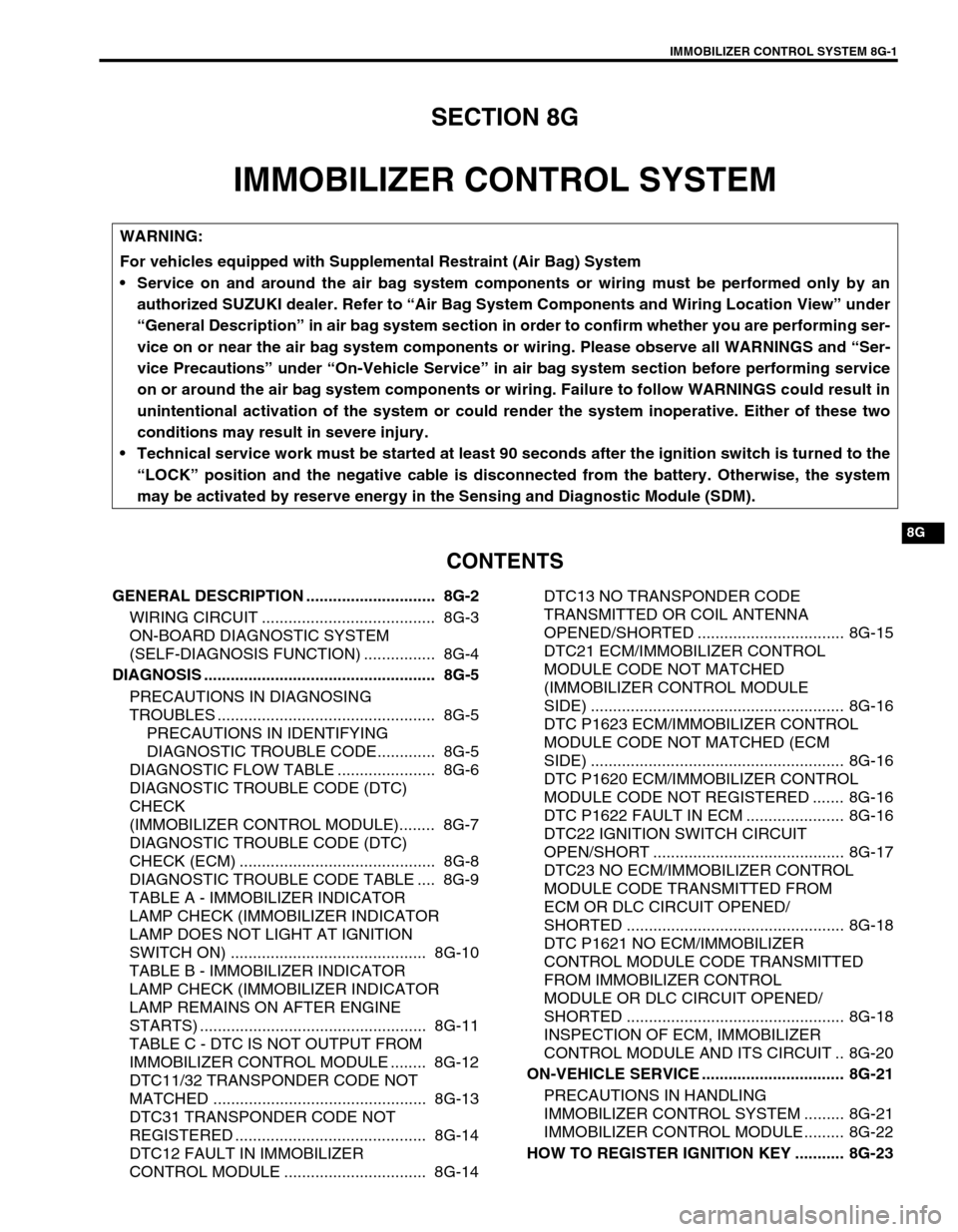
IMMOBILIZER CONTROL SYSTEM 8G-1
6F1
6F2
6G
6H
6K
7A
7A1
7B1
7C1
7D
7E
7F
8A
8B
8C
8D
8G
9
10
10A
10B
SECTION 8G
IMMOBILIZER CONTROL SYSTEM
CONTENTS
GENERAL DESCRIPTION ............................. 8G-2
WIRING CIRCUIT ....................................... 8G-3
ON-BOARD DIAGNOSTIC SYSTEM
(SELF-DIAGNOSIS FUNCTION) ................ 8G-4
DIAGNOSIS .................................................... 8G-5
PRECAUTIONS IN DIAGNOSING
TROUBLES ................................................. 8G-5
PRECAUTIONS IN IDENTIFYING
DIAGNOSTIC TROUBLE CODE............. 8G-5
DIAGNOSTIC FLOW TABLE ...................... 8G-6
DIAGNOSTIC TROUBLE CODE (DTC)
CHECK
(IMMOBILIZER CONTROL MODULE)........ 8G-7
DIAGNOSTIC TROUBLE CODE (DTC)
CHECK (ECM) ............................................ 8G-8
DIAGNOSTIC TROUBLE CODE TABLE .... 8G-9
TABLE A - IMMOBILIZER INDICATOR
LAMP CHECK (IMMOBILIZER INDICATOR
LAMP DOES NOT LIGHT AT IGNITION
SWITCH ON) ............................................ 8G-10
TABLE B - IMMOBILIZER INDICATOR
LAMP CHECK (IMMOBILIZER INDICATOR
LAMP REMAINS ON AFTER ENGINE
STARTS) ................................................... 8G-11
TABLE C - DTC IS NOT OUTPUT FROM
IMMOBILIZER CONTROL MODULE ........ 8G-12
DTC11/32 TRANSPONDER CODE NOT
MATCHED ................................................ 8G-13
DTC31 TRANSPONDER CODE NOT
REGISTERED ........................................... 8G-14
DTC12 FAULT IN IMMOBILIZER
CONTROL MODULE ................................ 8G-14DTC13 NO TRANSPONDER CODE
TRANSMITTED OR COIL ANTENNA
OPENED/SHORTED ................................. 8G-15
DTC21 ECM/IMMOBILIZER CONTROL
MODULE CODE NOT MATCHED
(IMMOBILIZER CONTROL MODULE
SIDE) ......................................................... 8G-16
DTC P1623 ECM/IMMOBILIZER CONTROL
MODULE CODE NOT MATCHED (ECM
SIDE) ......................................................... 8G-16
DTC P1620 ECM/IMMOBILIZER CONTROL
MODULE CODE NOT REGISTERED ....... 8G-16
DTC P1622 FAULT IN ECM ...................... 8G-16
DTC22 IGNITION SWITCH CIRCUIT
OPEN/SHORT ........................................... 8G-17
DTC23 NO ECM/IMMOBILIZER CONTROL
MODULE CODE TRANSMITTED FROM
ECM OR DLC CIRCUIT OPENED/
SHORTED ................................................. 8G-18
DTC P1621 NO ECM/IMMOBILIZER
CONTROL MODULE CODE TRANSMITTED
FROM IMMOBILIZER CONTROL
MODULE OR DLC CIRCUIT OPENED/
SHORTED ................................................. 8G-18
INSPECTION OF ECM, IMMOBILIZER
CONTROL MODULE AND ITS CIRCUIT .. 8G-20
ON-VEHICLE SERVICE ................................ 8G-21
PRECAUTIONS IN HANDLING
IMMOBILIZER CONTROL SYSTEM ......... 8G-21
IMMOBILIZER CONTROL MODULE ......... 8G-22
HOW TO REGISTER IGNITION KEY ........... 8G-23 WARNING:
For vehicles equipped with Supplemental Restraint (Air Bag) System
Service on and around the air bag system components or wiring must be performed only by an
authorized SUZUKI dealer. Refer to “Air Bag System Components and Wiring Location View” under
“General Description” in air bag system section in order to confirm whether you are performing ser-
vice on or near the air bag system components or wiring. Please observe all WARNINGS and “Ser-
vice Precautions” under “On-Vehicle Service” in air bag system section before performing service
on or around the air bag system components or wiring. Failure to follow WARNINGS could result in
unintentional activation of the system or could render the system inoperative. Either of these two
conditions may result in severe injury.
Technical service work must be started at least 90 seconds after the ignition switch is turned to the
“LOCK” position and the negative cable is disconnected from the battery. Otherwise, the system
may be activated by reserve energy in the Sensing and Diagnostic Module (SDM).
Page 292 of 447

8G-14 IMMOBILIZER CONTROL SYSTEM
DTC31 TRANSPONDER CODE NOT REGISTERED
DESCRIPTION
Immobilizer Control Module checks if Transponder code transmitted from ignition key and that registered in
Immobilizer Control Module match when ignition switch is ON. If there is no Transponder code registered in
Immobilizer Control Module, this DTC is set.
INSPECTION
Register ignition key with built-in transponder by using SUZUKI scan tool and performing following steps.
1) Register Transponder code in Immobilizer Control Module by performing procedure described in “How To
Register Ignition Key”.
2) Turn ignition switch OFF, then turn it ON and check that DTC31 is not set.
DTC12 FAULT IN IMMOBILIZER CONTROL MODULE
DESCRIPTION
This DTC is set when an internal fault is detected in Immobilizer Control Module.
INSPECTION
Step Action Yes No
1 1) Ignition switch OFF.
2) Disconnect connectors from Immobilizer
Control Module.
3) Check for proper connection to Immobilizer
Control Module at all terminals.
Are they in good condition?Substitute a known-good
Immobilizer Control Module
and recheck.
See NOTE below.Repair or replace.
NOTE:
After replacing with a known-good Immobilizer Control Module, register ECM/Immobilizer Control
Module code in ECM and Transponder code and ECM/Immobilizer Control Module code in Immobilizer
Control Module by performing procedure described in “PROCEDURE AFTER IMMOBILIZER CON-
TROL MODULE REPLACEMENT” in this section.
Page 294 of 447

8G-16 IMMOBILIZER CONTROL SYSTEM
DTC21 ECM/IMMOBILIZER CONTROL MODULE CODE NOT MATCHED (IMMO-
BILIZER CONTROL MODULE SIDE)
DTC P1623 ECM/IMMOBILIZER CONTROL MODULE CODE NOT MATCHED
(ECM SIDE)
DTC P1620 ECM/IMMOBILIZER CONTROL MODULE CODE NOT REGISTERED
DESCRIPTION
DTC21
Immobilizer Control Module checks if ECM/Immobilizer Control Module code transmitted from ECM and that
registered in Immobilizer Control Module match when ignition switch is ON. If they do not, this DTC is set.
DTC P1623
ECM checks if ECM/Immobilizer Control Module code transmitted from Immobilizer Control Module and that
registered in ECM match when ignition switch is ON. If they do not, this DTC is set.
DTC P1620
ECM checks if code transmitted from Immobilizer Control Module and that registered in ECM match when
ignition switch is ON. If there is no ECM/Immobilizer Control Module code registered in ECM, this DTC is
set.
INSPECTION
Perform procedure described in “PROCEDURE AFTER ECM REPLACEMENT” in the section.
DTC P1622 FAULT IN ECM
DESCRIPTION
This DTC is set when an internal fault is detected in ECM.
INSPECTION
Step Action Yes No
1 1) Ignition switch OFF.
2) Disconnect connectors from ECM.
3) Check for proper connection to ECM
at all terminals.
Are they in good condition?Substitute a known-good ECM and
recheck.
See NOTE below.Repair or replace.
NOTE:
After replacing with a known-good ECM, register ECM/Immobilizer Control Module code in ECM by
performing procedure described in “PROCEDURE AFTER ECM REPLACEMENT” in this section.
Page 305 of 447
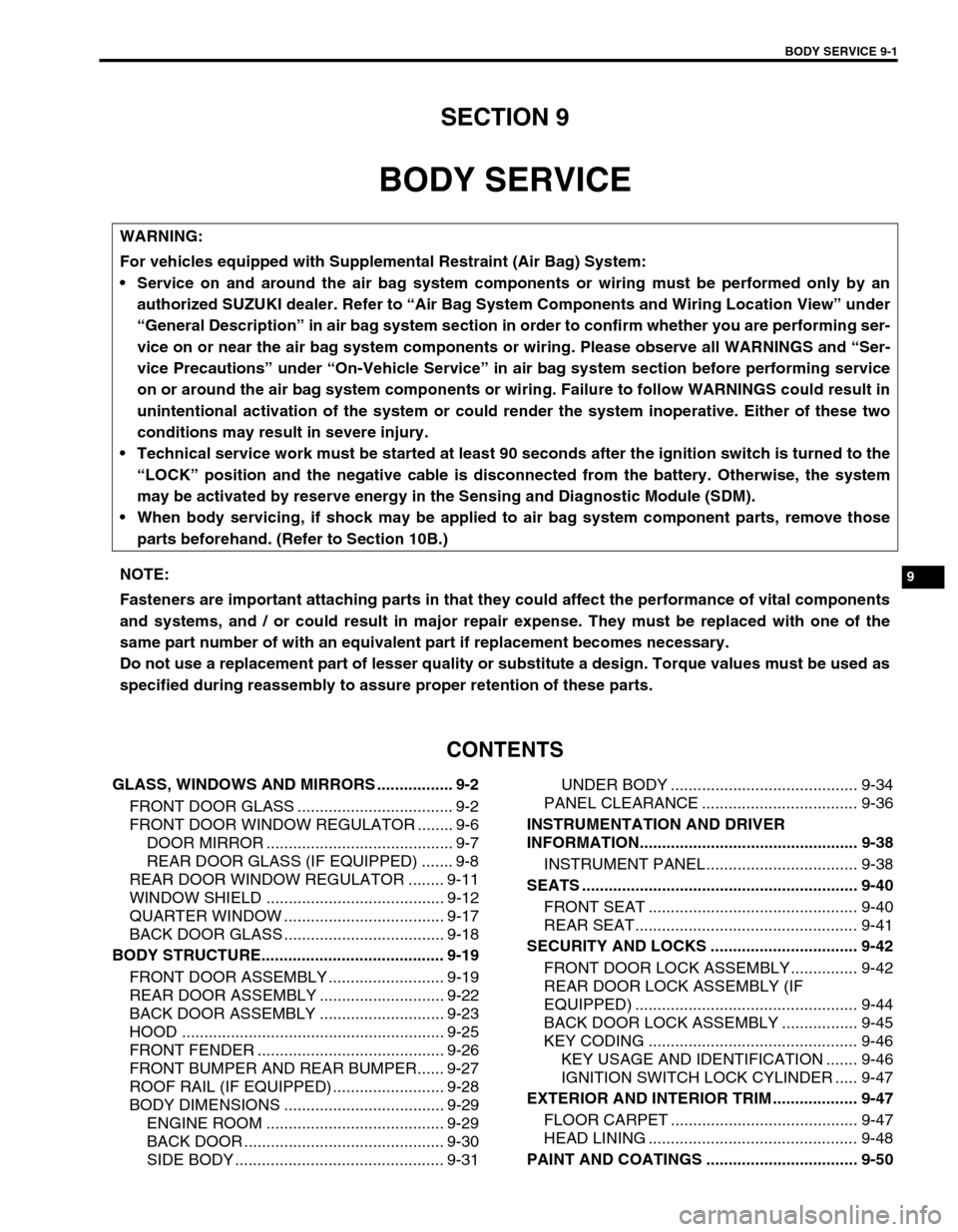
BODY SERVICE 9-1
6F1
6F2
6G
6H
6K
7A
7A1
7B1
7C1
7D
7E
7F
8A
8B
8C
8D
8E
9
10
10A
10B
SECTION 9
BODY SERVICE
CONTENTS
GLASS, WINDOWS AND MIRRORS ................. 9-2
FRONT DOOR GLASS ................................... 9-2
FRONT DOOR WINDOW REGULATOR ........ 9-6
DOOR MIRROR .......................................... 9-7
REAR DOOR GLASS (IF EQUIPPED) ....... 9-8
REAR DOOR WINDOW REGULATOR ........ 9-11
WINDOW SHIELD ........................................ 9-12
QUARTER WINDOW .................................... 9-17
BACK DOOR GLASS .................................... 9-18
BODY STRUCTURE......................................... 9-19
FRONT DOOR ASSEMBLY .......................... 9-19
REAR DOOR ASSEMBLY ............................ 9-22
BACK DOOR ASSEMBLY ............................ 9-23
HOOD ........................................................... 9-25
FRONT FENDER .......................................... 9-26
FRONT BUMPER AND REAR BUMPER...... 9-27
ROOF RAIL (IF EQUIPPED) ......................... 9-28
BODY DIMENSIONS .................................... 9-29
ENGINE ROOM ........................................ 9-29
BACK DOOR ............................................. 9-30
SIDE BODY ............................................... 9-31UNDER BODY .......................................... 9-34
PANEL CLEARANCE ................................... 9-36
INSTRUMENTATION AND DRIVER
INFORMATION................................................. 9-38
INSTRUMENT PANEL .................................. 9-38
SEATS .............................................................. 9-40
FRONT SEAT ............................................... 9-40
REAR SEAT.................................................. 9-41
SECURITY AND LOCKS ................................. 9-42
FRONT DOOR LOCK ASSEMBLY............... 9-42
REAR DOOR LOCK ASSEMBLY (IF
EQUIPPED) .................................................. 9-44
BACK DOOR LOCK ASSEMBLY ................. 9-45
KEY CODING ............................................... 9-46
KEY USAGE AND IDENTIFICATION ....... 9-46
IGNITION SWITCH LOCK CYLINDER ..... 9-47
EXTERIOR AND INTERIOR TRIM ................... 9-47
FLOOR CARPET .......................................... 9-47
HEAD LINING ............................................... 9-48
PAINT AND COATINGS .................................. 9-50 WARNING:
For vehicles equipped with Supplemental Restraint (Air Bag) System:
Service on and around the air bag system components or wiring must be performed only by an
authorized SUZUKI dealer. Refer to “Air Bag System Components and Wiring Location View” under
“General Description” in air bag system section in order to confirm whether you are performing ser-
vice on or near the air bag system components or wiring. Please observe all WARNINGS and “Ser-
vice Precautions” under “On-Vehicle Service” in air bag system section before performing service
on or around the air bag system components or wiring. Failure to follow WARNINGS could result in
unintentional activation of the system or could render the system inoperative. Either of these two
conditions may result in severe injury.
Technical service work must be started at least 90 seconds after the ignition switch is turned to the
“LOCK” position and the negative cable is disconnected from the battery. Otherwise, the system
may be activated by reserve energy in the Sensing and Diagnostic Module (SDM).
When body servicing, if shock may be applied to air bag system component parts, remove those
parts beforehand. (Refer to Section 10B.)
NOTE:
Fasteners are important attaching parts in that they could affect the performance of vital components
and systems, and / or could result in major repair expense. They must be replaced with one of the
same part number of with an equivalent part if replacement becomes necessary.
Do not use a replacement part of lesser quality or substitute a design. Torque values must be used as
specified during reassembly to assure proper retention of these parts.
Page 354 of 447
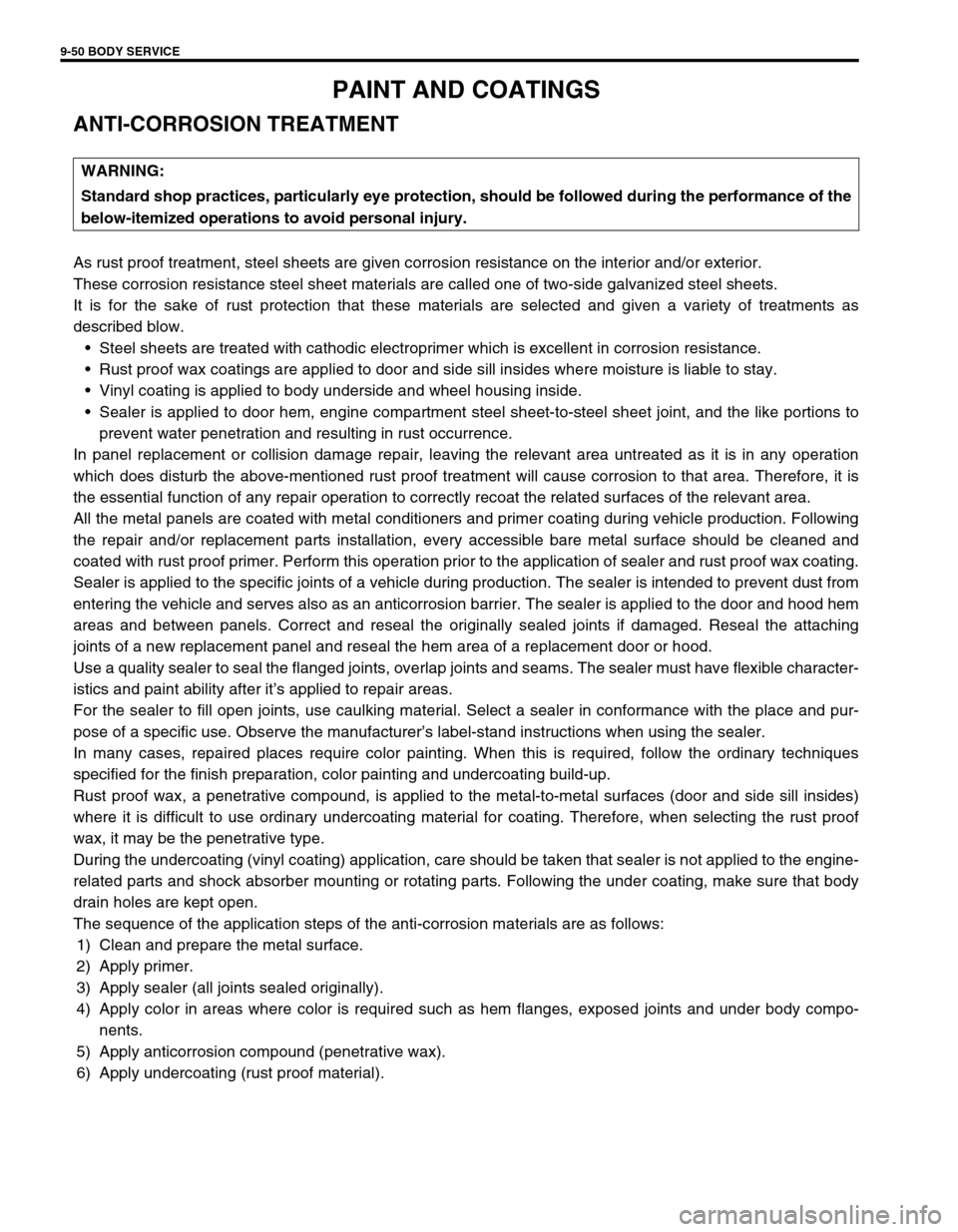
9-50 BODY SERVICE
PAINT AND COATINGS
ANTI-CORROSION TREATMENT
As rust proof treatment, steel sheets are given corrosion resistance on the interior and/or exterior.
These corrosion resistance steel sheet materials are called one of two-side galvanized steel sheets.
It is for the sake of rust protection that these materials are selected and given a variety of treatments as
described blow.
Steel sheets are treated with cathodic electroprimer which is excellent in corrosion resistance.
Rust proof wax coatings are applied to door and side sill insides where moisture is liable to stay.
Vinyl coating is applied to body underside and wheel housing inside.
Sealer is applied to door hem, engine compartment steel sheet-to-steel sheet joint, and the like portions to
prevent water penetration and resulting in rust occurrence.
In panel replacement or collision damage repair, leaving the relevant area untreated as it is in any operation
which does disturb the above-mentioned rust proof treatment will cause corrosion to that area. Therefore, it is
the essential function of any repair operation to correctly recoat the related surfaces of the relevant area.
All the metal panels are coated with metal conditioners and primer coating during vehicle production. Following
the repair and/or replacement parts installation, every accessible bare metal surface should be cleaned and
coated with rust proof primer. Perform this operation prior to the application of sealer and rust proof wax coating.
Sealer is applied to the specific joints of a vehicle during production. The sealer is intended to prevent dust from
entering the vehicle and serves also as an anticorrosion barrier. The sealer is applied to the door and hood hem
areas and between panels. Correct and reseal the originally sealed joints if damaged. Reseal the attaching
joints of a new replacement panel and reseal the hem area of a replacement door or hood.
Use a quality sealer to seal the flanged joints, overlap joints and seams. The sealer must have flexible character-
istics and paint ability after it’s applied to repair areas.
For the sealer to fill open joints, use caulking material. Select a sealer in conformance with the place and pur-
pose of a specific use. Observe the manufacturer’s label-stand instructions when using the sealer.
In many cases, repaired places require color painting. When this is required, follow the ordinary techniques
specified for the finish preparation, color painting and undercoating build-up.
Rust proof wax, a penetrative compound, is applied to the metal-to-metal surfaces (door and side sill insides)
where it is difficult to use ordinary undercoating material for coating. Therefore, when selecting the rust proof
wax, it may be the penetrative type.
During the undercoating (vinyl coating) application, care should be taken that sealer is not applied to the engine-
related parts and shock absorber mounting or rotating parts. Following the under coating, make sure that body
drain holes are kept open.
The sequence of the application steps of the anti-corrosion materials are as follows:
1) Clean and prepare the metal surface.
2) Apply primer.
3) Apply sealer (all joints sealed originally).
4) Apply color in areas where color is required such as hem flanges, exposed joints and under body compo-
nents.
5) Apply anticorrosion compound (penetrative wax).
6) Apply undercoating (rust proof material).WARNING:
Standard shop practices, particularly eye protection, should be followed during the performance of the
below-itemized operations to avoid personal injury.
Page 365 of 447

BODY SERVICE 9-61
PLASTIC PARTS FINISHING
Paintable plastic parts are ABS plastic parts.
Painting
Rigid or hand ABS plastic needs no primer coating.
General acrylic lacquers can be painted properly over hard ABS plastic in terms of adherence.
1) Use cleaning solvent for paint finish to wash each part.
2) Apply conventional acrylic color lacquer to part surface.
3) Follow lacquer directions for required drying time. (Proper drying temperature range is 60 – 70 °C (140 – 158
°F)).
Reference
Plastic parts employ not only ABS (Acrylonitrile Butadiene Styrene) plastic but also polypropylene, vinyl, or the
like plastic. Burning test method to identify ABS plastic is described below.
1) Use a sharp blade to cut off a plastic sliver from the part at its hidden backside.
2) Hold sliver with pincers and set it on fire.
3) Carefully observe condition of the burning plastic.
4) ABS plastic must raise readily distinguishable back smoke while burning with its residue suspended in air
temporarily.
5) Polypropylene must raise no readily distinguishable smoke while burning.
REQUIRED SERVICE MATERIAL
Material Recommended SUZUKI product Use
Lithium grease SUZUKI SUPER GREASE A
(99000-25010)Window regulator
Door hinge
Sealant SUZUKI BOND No. 1215
(99000-31110)Hood hinge
Door hinge
Page 367 of 447

RESTRAINT SYSTEM 10-1
6F1
6F2
6G
6H
6K
7A
7A1
7B1
7C1
7D
7E
7F
8A
8B
8C
8D
8E
9
10
10A
10B
SECTION 10
RESTRAINT SYSTEM
CONTENTS
GENERAL DESCRIPTION .............................. 10-2
SYSTEM SPECIFICATION .......................... 10-3
SEAT BELT PRETENSIONER
(IF EQUIPPED) ............................................ 10-3
DIAGNOSIS ..................................................... 10-3
INSPECTION AND REPAIR REQUIRED
AFTER ACCIDENT ...................................... 10-3
ON-VEHICLE SERVICE .................................. 10-4SERVICE PRECAUTIONS .......................... 10-4
SERVICE AND DIAGNOSIS .................... 10-4
DISABLING AIR BAG SYSTEM............... 10-4
ENABLING AIR BAG SYSTEM................ 10-4
HANDLING AND STORAGE ................... 10-4
DISPOSAL ............................................... 10-4
FRONT SEAT BELT .................................... 10-5
REAR SEAT BELT....................................... 10-8
WARNING:
For vehicles equipped with Supplemental Restraint (Air Bag) System with seat belt pretensioner:
Service on or around the air bag system components or wiring must be performed only by an
authorized SUZUKI dealer. Please observe all WARNINGS and “Service Precautions” under “On-
Vehicle Service” in air bag system section before performing service on or around the air bag sys-
tem components or wiring. Failure to follow WARNINGS could result in unintentional activation of
the system or could render the system inoperative. Either of these two conditions may result in
severe injury.
The procedures in this section must be followed in the order listed to disable the air bag system
temporarily and prevent false diagnostic trouble codes from setting. Failure to follow procedures
could result in possible activation of the air bag system, personal injury or otherwise unneeded air
bag system repairs.
CAUTION:
When fasteners are removed, always reinstall them at the same location from which they were
removed. If a fastener needs to be replaced, use the correct part number fastener for that application.
If the correct part number fastener is not available, a fastener of equal size and strength (or stronger)
may be used. Fasteners that are not reused, and those requiring thread-locking compound, will be
called out. The correct torque value must be used when installing fasteners that require it. If the above
procedures are not followed, parts or system damage could result.